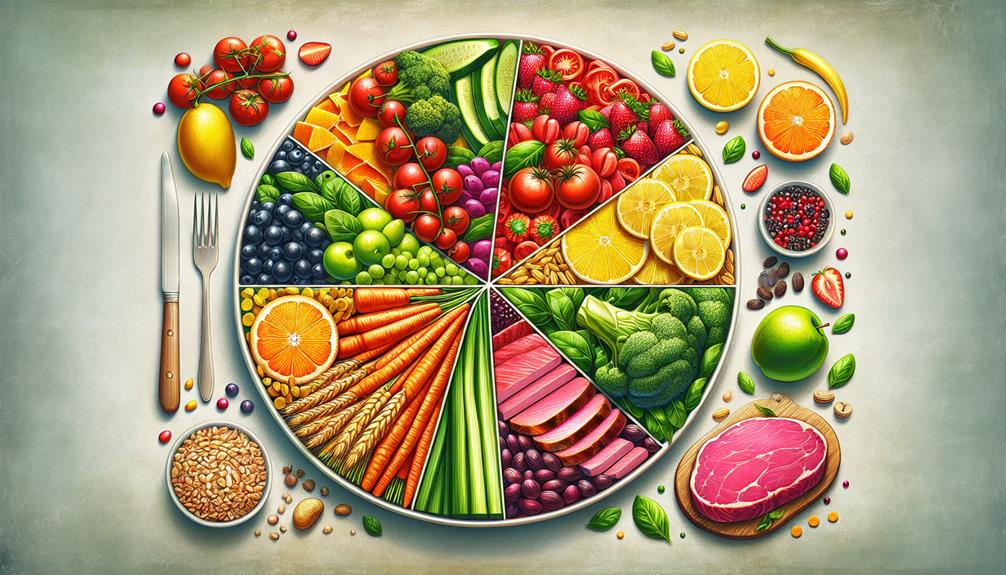Did you know that according to recent studies, only 1 in 10 adults in the United States meet the daily recommended intake of fruits and vegetables? It's a startling statistic that highlights the importance of healthy eating and proper nutrition. In this ultimate guide, we will explore the basics of nutrition and provide you with practical tips and information to help you make smarter food choices. From understanding macronutrients and micronutrients to decoding nutritional labels, we will cover all the essential aspects of healthy eating. So, if you're looking to improve your diet and overall well-being, this guide is for you. Get ready to embark on a journey towards a healthier lifestyle.
Key Takeaways
- Balanced nutrition is crucial for maintaining optimal health and preventing chronic diseases like heart disease and diabetes.
- Macronutrients (carbohydrates, proteins, and fats) provide energy, while micronutrients (vitamins and minerals) are essential for overall health.
- Building a healthy plate involves portion control, including fruits, vegetables, lean proteins, whole grains, and dairy or dairy alternatives.
- Choosing whole foods over processed foods is important as whole foods are rich in nutrients and fiber, while processed foods are low in nutrients and may increase the risk of chronic diseases.
The Importance of Balanced Nutrition
Eating a balanced diet is essential for maintaining optimal health and well-being. A balanced diet provides the body with the necessary nutrients it needs to function properly and stay healthy. Nutrients play a crucial role in overall health, as they are responsible for various bodily functions, such as energy production, growth, and repair.
One of the key benefits of balanced nutrition is its impact on disease prevention. Nutrient-rich foods, such as fruits, vegetables, whole grains, lean proteins, and healthy fats, contain an array of vitamins, minerals, antioxidants, and phytochemicals that help boost the immune system and protect against chronic diseases, such as heart disease, diabetes, and certain types of cancer.
For instance, consuming a diet rich in fruits and vegetables provides the body with essential vitamins and minerals, such as vitamin C, vitamin A, and potassium, which are known to support immune function and reduce the risk of developing chronic diseases. Additionally, foods high in fiber, such as whole grains and legumes, can help lower cholesterol levels and reduce the risk of heart disease.
Understanding Macronutrients and Micronutrients
To better understand healthy eating, it is important to grasp the concepts of macronutrients and micronutrients. Macronutrients are the nutrients that provide energy and are needed in large amounts by the body. They include carbohydrates, proteins, and fats. Carbohydrates are the body's main source of energy, while proteins are essential for building and repairing tissues. Fats, although often demonized, are actually important for hormone production and the absorption of fat-soluble vitamins.
On the other hand, micronutrients are required in smaller amounts but are still vital for overall health. They include vitamins and minerals. Vitamins are organic compounds that help regulate bodily processes, while minerals are inorganic substances that contribute to various functions such as bone health and nerve function.
When it comes to nutrient absorption and digestion, macronutrients and micronutrients are processed differently. Macronutrients need to be broken down into smaller molecules before they can be absorbed by the body. For example, carbohydrates are broken down into glucose, proteins into amino acids, and fats into fatty acids. Micronutrients, on the other hand, are absorbed directly into the bloodstream or stored in the liver for later use.
Understanding the difference between macronutrients and micronutrients is crucial for making informed food choices. A balanced diet that includes an appropriate amount of both macronutrients and micronutrients is essential for maintaining optimal health.
Building a Healthy Plate: Portion Control and Food Groups

Now that you understand the importance of macronutrients and micronutrients, let's explore how to build a healthy plate through portion control and food groups. By paying attention to portion sizes and including a variety of food groups, you can ensure that you are getting the right balance of nutrients for optimal health. Here are some tips to help you build a healthy plate:
- Control your portion sizes:
- Use smaller plates and bowls to help you control portion sizes.
- Measure your food using measuring cups or a food scale to ensure accuracy.
- Include all food groups:
- Fruits and vegetables: Aim for at least half of your plate to be filled with colorful fruits and vegetables.
- Protein: Include lean sources of protein such as chicken, fish, beans, or tofu.
- Whole grains: Choose whole grain options like brown rice, quinoa, or whole wheat bread.
- Dairy or dairy alternatives: Include low-fat milk, yogurt, or plant-based alternatives like almond milk.
Smart Food Choices: Whole Foods Vs. Processed Foods
When making smart food choices, it is important to understand the difference between whole foods and processed foods. Whole foods are foods that are in their natural form, with minimal processing or refinement. They are rich in nutrients, fiber, and phytochemicals, which are beneficial for your health. On the other hand, processed foods have undergone various alterations and often contain added sugars, unhealthy fats, and artificial ingredients. They typically lack the same nutritional value as whole foods and may contribute to health problems when consumed in excess.
To help you make informed choices, here is a table comparing the benefits of whole foods and the drawbacks of processed foods:
| Whole Foods Benefits | Processed Foods Drawbacks |
|---|---|
| High in Nutrients | Low in Nutrients |
| Rich in Fiber | Low in Fiber |
| Contain Phytochemicals | Contain Artificial Ingredients |
| Promote Fullness | May Contribute to Overeating |
| Support Good Health | May Increase Chronic Disease Risk |
Choosing whole foods over processed foods is a smart way to nourish your body. Whole foods provide essential nutrients and fiber, which are important for maintaining a healthy weight, reducing the risk of chronic diseases, and promoting overall well-being. Processed foods, on the other hand, often lack these nutrients and are associated with negative health effects. By making whole foods the foundation of your diet, you can optimize your nutrition and support your long-term health goals.
Reading Labels: Decoding Nutritional Information

Understanding the difference between whole foods and processed foods sets the foundation for being able to read and decode the nutritional information on food labels effectively. Decoding food labels is essential for making informed choices about the foods you consume. Here are two key points to help you understand nutritional values and decode food labels:
- Serving Size and Servings per Container:
- Pay attention to the serving size indicated on the label. This is the amount of food that the nutritional information is based on.
- Also, check the number of servings per container. This will help you determine how many servings you are consuming if you eat the whole package.
- Nutritional Values:
- Look for the total calories per serving. This will give you an idea of the energy content in the food.
- Check the amounts of fat, cholesterol, sodium, carbohydrates, fiber, sugars, and protein. These values are usually listed in grams and can help you understand the nutrient composition of the food.
Tips for Incorporating Healthy Eating Into Your Lifestyle
To incorporate healthy eating into your lifestyle, it's important to make mindful choices about the foods you consume. One effective strategy is meal prepping, which involves preparing and portioning out your meals in advance. This can save you time and ensure that you have healthy options readily available. Plan your meals for the week, create a shopping list, and set aside time to cook and pack your meals. By doing this, you can avoid unhealthy takeout or processed foods when you're busy or tired.
Another key aspect of healthy eating is incorporating nutritious snacks into your daily routine. Snacking can help prevent overeating during meals and keep your energy levels stable throughout the day. Opt for snacks that are rich in nutrients and low in added sugars and unhealthy fats. Here are some examples of healthy snacks that you can include in your diet:
| Category | Snack Options |
|---|---|
| Fruits | Apples, bananas, berries |
| Vegetables | Carrot sticks, cherry tomatoes |
| Nuts and Seeds | Almonds, walnuts, chia seeds |
| Dairy | Greek yogurt, cottage cheese |
| Protein | Hard-boiled eggs, turkey slices |
Frequently Asked Questions
What Are Some Common Misconceptions About Healthy Eating?
You might have some misconceptions about healthy eating. Let's clear them up. Healthy eating doesn't mean giving up all your favorite foods. It's about balance, portion control, and making smart choices.
How Does Stress Affect Our Eating Habits and Overall Health?
Stress can significantly impact your eating habits and overall health. It can lead to emotional eating, cravings for unhealthy foods, and disruptions in appetite and digestion. Additionally, stress can negatively affect your mental health, leading to further imbalances in your overall well-being.
Are There Any Specific Foods or Diets That Can Boost Our Immune System?
Boost your immune system with specific foods and diets. Incorporate immune boosting foods like citrus fruits, yogurt, and garlic. Consider following a diet rich in fruits, vegetables, lean proteins, and whole grains for a strong immune system.
How Can We Ensure Adequate Hydration While Following a Healthy Eating Plan?
To ensure adequate hydration while following a healthy eating plan, you can incorporate hydration strategies like drinking enough water throughout the day and consuming hydrating foods. Staying hydrated has numerous benefits for your overall health and well-being.
What Are Some Strategies for Overcoming Cravings and Maintaining a Healthy Eating Routine?
To overcome cravings and maintain a healthy eating routine, try mindful eating strategies. Pause before eating, tune into your hunger and fullness cues, and choose nutritious foods that satisfy you.
Conclusion
In conclusion, adopting a healthy eating lifestyle is essential for overall well-being. By understanding the importance of balanced nutrition, incorporating whole foods into your diet, and practicing portion control, you can fuel your body with the nutrients it needs. Remember to read labels and choose foods that are minimally processed. By making smart food choices and incorporating these tips into your daily routine, you can achieve and maintain a healthy lifestyle. So why wait? Start making positive changes today and reap the benefits of a nutritious diet.













